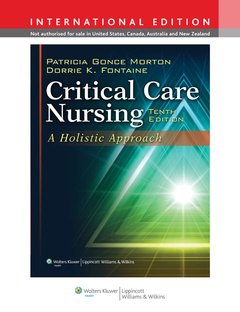Description
Critical Care Nursing (10th Ed., International Edition)
A Holistic Approach
Authors: Morton Patricia Gonce, Fontaine Dorrie K.
Language: English
Subject for Critical Care Nursing:
1352 p. · 21.3x27.6 cm · Hardback
Replaced by new edition
Description
/li>Contents
/li>
NEW!! Patient Safety boxes guide safe and effective practice by alerting the critical care nurse of risk factors, signs and symptoms, side effects, and complications.
Nursing Interventions tables and boxes highlight key information for the critical care nurse
Part 1 The Concept of Holism Applied to Critical Care Nursing Practice
1 Critical Care Nursing Practice: Promoting Excellence Through Caring, Collaboration, and Evidence
2 The Patient’s Experience With Critical Illness
3 The Family’s Experience With Critical Illness
4 Patient and Family Education in Critical Care
5 Relieving Pain and Providing Comfort
6 Palliative Care and End-of-Life Issues in Critical Care
Part 2 Professional Practice Issues in Critical Care
7 Ethical Issues in Critical Care Nursing
8 Legal Issues in Critical Care Nursing
9 Building a Professional Practice Model for Excellence in Critical Care Nursing
Part 3 Special Populations in Critical Care
10 The Critically Ill Pediatric Patient
11 The Critically Ill Pregnant Woman
12 The Critically Ill Older Patient
13 The Postanesthesia Patient
Part 4 Special Situations in Critical Care
14 Rapid Response Teams and Transport of the Critically Ill Patient
15 Disaster Management: Implications for the Critical Care Nurse
Part 5 Cardiovascular System
16 Anatomy and Physiology of the Cardiovascular System
17 Patient Assessment: Cardiovascular System
18 Patient Management: Cardiovascular System
19 Common Cardiovascular Disorders
20 Heart Failure
21 Acute Myocardial Infarction
22 Cardiac Surgery
Part 6 Respiratory System
23 Anatomy and Physiology of the Respiratory System
24 Patient Assessment: Respiratory System
25 Patient Management: Respiratory System
26 Common Respiratory Disorders
27 Acute Lung Injury and Acute Respiratory Distress Syndrome
Part 7 Renal System
28 Anatomy and Physiology of the Renal System
29 Patient Assessment: Renal System
30 Patient Management: Renal System
31 Renal Failure
Part 8 Nervous System
32 Anatomy and Physiology of the Nervous System
33 Patient Assessment: Nervous System
34 Patient Management: Nervous System
35 Common Neurosurgical and Neurological Disorders
36 Traumatic Brain Injury
37 Spinal Cord Injury
Part 9 Gastrointestinal System
38 Anatomy and Physiology of the Gastrointestinal System
39 Patient Assessment: Gastrointestinal System
40 Patient Management: Gastrointestinal System
41 Common Gastrointestinal Disorders
Part 10 Endocrine System
42 Anatomy and Physiology of the Endocrine System
43 Patient Assessment: Endocrine System
44 Common Endocrine Disorders
Part 11 Hematological and Immune Systems
45 Anatomy and Physiology of the Hematological and Immune Systems
46 Patient Assessment: Hematological and Immune Systems
47 Organ and Hematopoietic Stem Cell Transplantation
48 Common Immunological Disorders
49 Common Hematological Disorders
Part 12 Integumentary System
50 Anatomy and Physiology of the Integumentary System
51 Patient Assessment: Integumentary System
52 Patient Management: Integumentary System
53 Burns and Common Integumentary Disorders
Part 13 Multisystem Dysfunction
54 Shock, Systemic Inflammatory Response Syndrome, and Multiple Organ Dysfunction Syndrome
55 Trauma
56 Drug Overdose and Poisoning
Appendix: ACLS Guidelines




